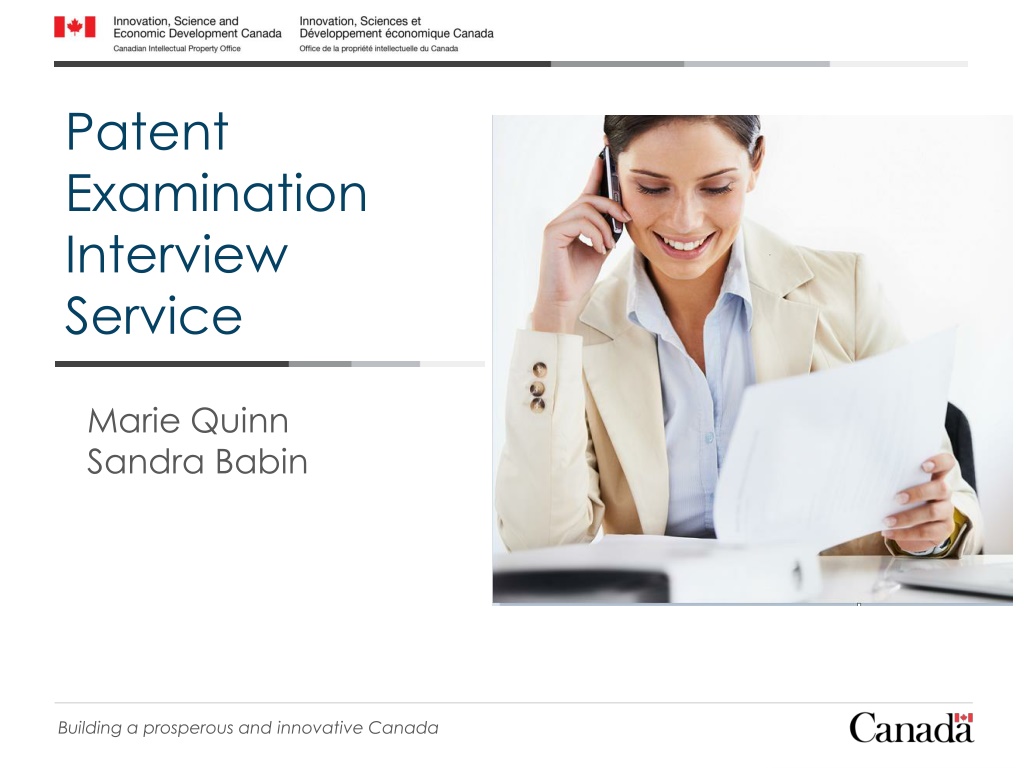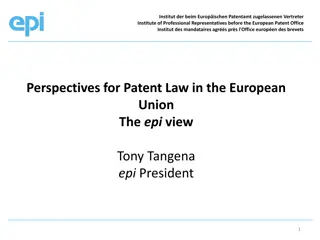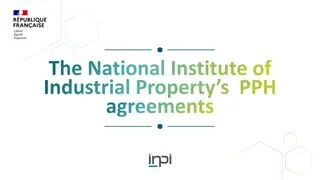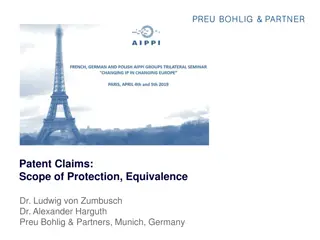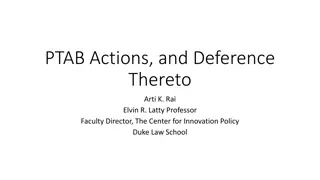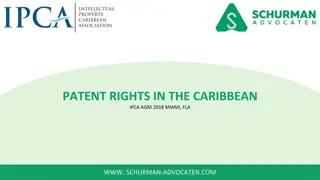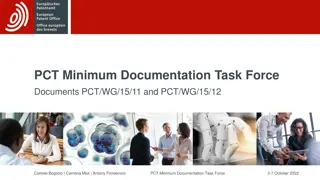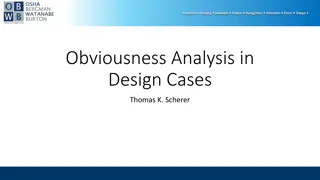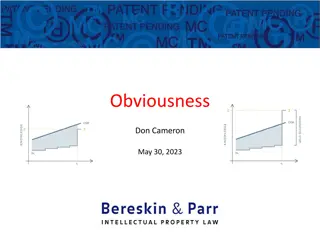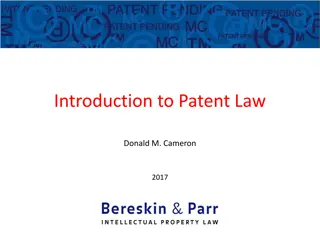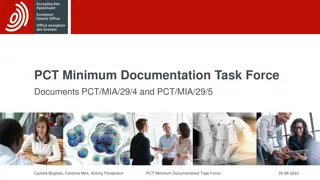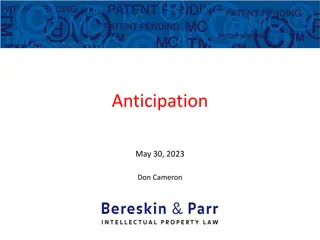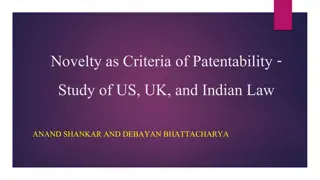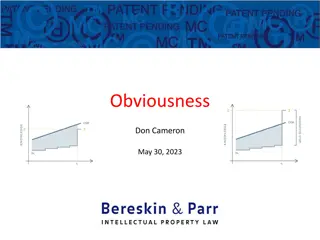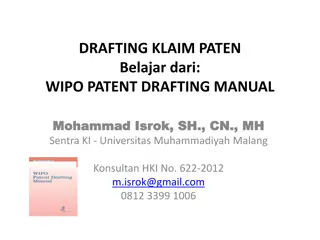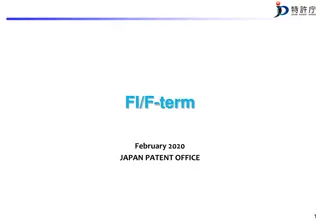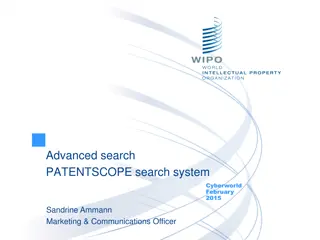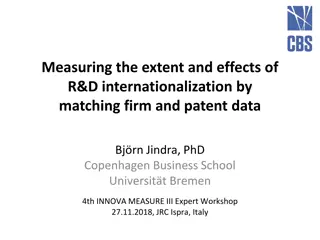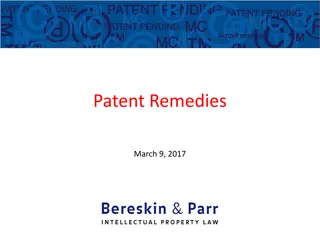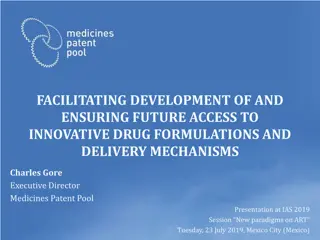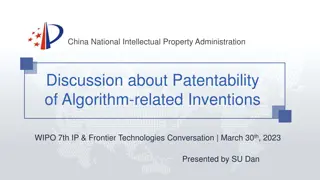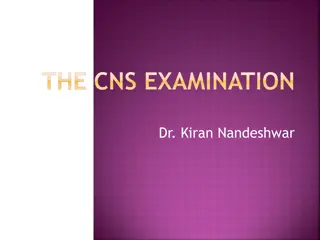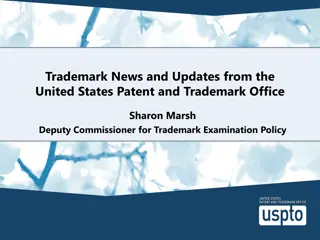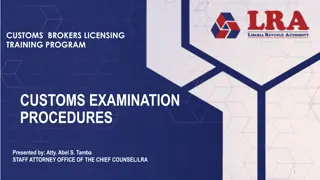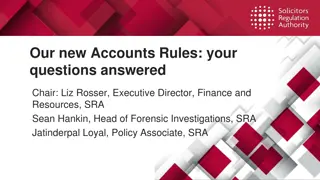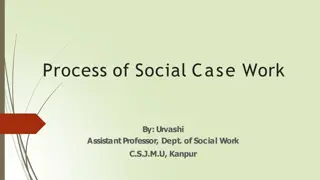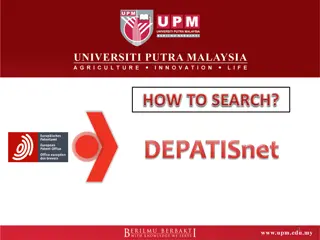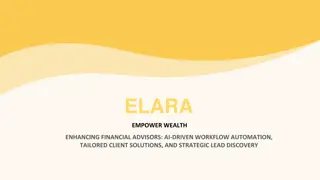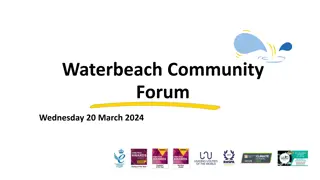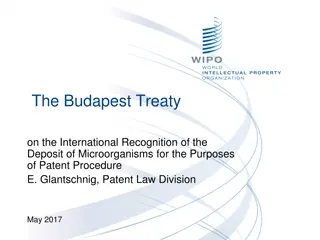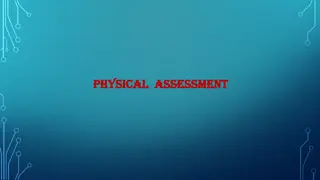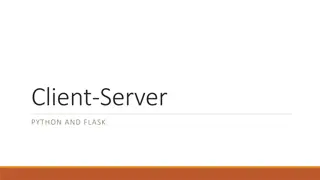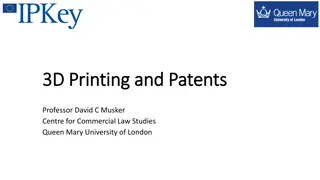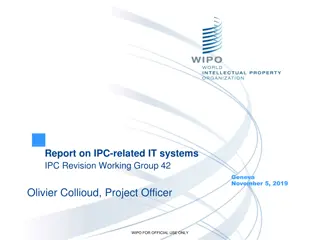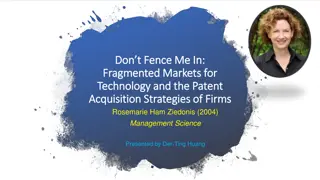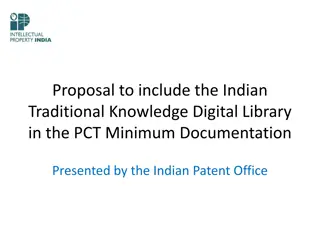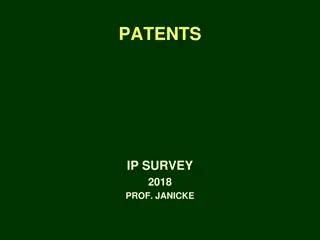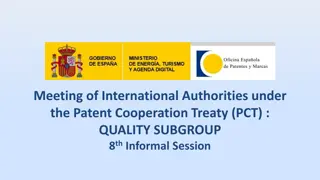Streamlining Patent Examination Process for Enhanced Client Service
Patent Examination Interview Service by Marie Quinn and Sandra Babin focuses on reducing pendency and complexity in patent prosecution through telephone interviews. The initiative aims to enhance client service, expedite patent issuance, and align CIPO processes with other international patent offices like USPTO, EPO, UK, and Sweden. A successful pilot program demonstrated high satisfaction rates and effectiveness in advancing prosecution.
Download Presentation

Please find below an Image/Link to download the presentation.
The content on the website is provided AS IS for your information and personal use only. It may not be sold, licensed, or shared on other websites without obtaining consent from the author. Download presentation by click this link. If you encounter any issues during the download, it is possible that the publisher has removed the file from their server.
E N D
Presentation Transcript
Patent Examination Interview Service Marie Quinn Sandra Babin Building a prosperous and innovative Canada
The Patent Examination Interview Service Provides examiners with the opportunity to prosecute patent applications by telephone in order to reduce pendency, prosecution complexity, and risk of impasse. Examiners are encouraged to initiate phone interviews in cases where advancing prosecution is likely. Provides a mechanism for formally documenting phone conversations with agents and private inventors. Patent Branch and Business Services Branch initiative. 2
Purpose of the Interview Service To improve client service and reduce pendency. Helps our clients get their patents faster. Responds to requests from agents for increased direct communication with examiners. IPIC requested that examiners call agents as applications approach allowance. Puts CIPO in-line with other IP offices, such as the USPTO, EPO, UK and Sweden, who routinely communicate with patent agents by phone. 3
Addresses a need to update the current interview process. Reduces variability between how examiners communicate with agents. Introduces a formal mechanism to document this form of communication. 4
Interview Service Pilot A 6 month pilot of the interview service was conducted last year with 74 examiners. 249 examiner-initiated phone interviews conducted. 98% initiated to correct a minor defect. 93% of agents submitted a voluntary amendment (VA) to correct defects when requested by the examiner. On average, VA received 8.1 days from interview date. Allowance rate of 90%. 92% of pilot participants felt the interview service was effective in advancing prosecution. 96% of agents were satisfied or very satisfied with the interview service. 5
When to initiate an interview 1. To correct a limited number of minor defects with the objective of making the application allowable. Examples of minor defects: Grammatical/typographical errors Not referring to a claim by number Period missing from the end of a claim sentence Incorrect page numbering Incorporation by reference What constitutes a limited number ? At the discretion of the examiner Generally1-3 defects 6
2. When the claims are so unclear that substantive examination and/or searching is not possible. Poor translation Ambiguous claims / multiple clarity issues Only to be used if it would be very difficult to examine/search all the claims. If some of the claims are clear and searchable, must prepare an office action on those claims 7
3. When the examiner receives a TT67 and a defect is identified that will limit the examiner s ability to examine the application and is one that should be corrected before the next examiner s report. The defect may be identified when the examiner is converting a TT67 into a TT56. The examiner may receive a TT67 - Defect Identified (see notation) from Exam Support identifying the defect. Examples of such defects include: Missing amended pages Illegible amended pages Missing or incorrect pages in the response to an examiner s report 8
4. Any time the examiner considers that an interview would be beneficial. This includes: When there has been an obvious miscommunication between the examiner and the agent To clarify the applicant s response to an examiner s report To discuss cited prior art When the examiner has a suggestion on how to overcome a defect Prior to writing a pre-final or final action 9
Considerations before initiating an interview: An examiner may only initiate an interview with the authorized correspondent. The appointed patent agent or the inventor(s), where no patent agent has been appointed. A lack of unity defect must be addressed by written office action. An invention cannot be formally elected during a phone interview due to the absence of a requisition under section 36(2). An examiner may not cite new prior art for the first time during a phone interview. 10
An examiner may request that the application and any proposed amendments be informally QC d by their SH prior to conducting the interview. An examiner should consider ways in which an identified defect may be corrected. If the examiner is calling to correct a minor defect in an application that is otherwise allowable, the examiner must ensure that the application has been fully and thoroughly examined. Review the prosecution of any related family members. Complete any necessary searches. Start the Search Record and record the family prosecution and search history, if a search was conducted. 11
The phone interview Ensure that the purpose of the interview and/or the items to be discussed is clearly communicated. Ask whether the authorized correspondent needs time to retrieve or review the case before further discussions. Discuss identified defects or cited prior art, offer opinions/suggestions on proposed amendments, suggest claims granted at another office may be acceptable, etc. If it appears that no common ground can be reached, the examiner may end the interview. 12
If calling to correct a defect in the application: Ask if the agent/applicant wishes to submit a VA to correct the defect. Provide a due date that is 15 business days (3 weeks) from the interview date for submission of the VA. State that a report will be issued if the VA is not submitted by the due date. State that the examiner will be preparing a summary of the conversation (i.e. the Interview Record). Mention that the Interview Record will be available on the Canadian Patent Database (CPD), if the agent/applicant would like to retrieve a copy for their own records. 13
What if the agent wishes to discuss the case with the client first? Provide the agent with a time frame in which they must confirm whether they wish to submit a VA. Generally a week, however the time frame may be extended at the examiner s discretion. If the examiner has not heard from the agent within that time frame, they should give them a call to ask if they have made a decision. 14
What if the agent does not wish to submit a voluntary amendment? If the application is under examination and the defect prevents the allowance of the application: Must write a report Identify defect and include the Interview Opening Paragraph PERM Create a TT45 (get credit for an action). No interview tasks are created in LOB. 15
Interview Opening Paragraph PERM This application has been examined taking into account the phone conversation of [Date]. As agreed during the phone conversation, the applicant does not wish to submit a voluntary amendment but rather has requested a written requisition be issued for this application. 16
For all other situations: Fill out the Interview Record detailing what was discussed. Create the appropriate task (TTI1 or TTI2) for the Outgoing Correspondence Unit (OCU) to have the Interview Record stored in LOB. If agent/applicant has indicated that they will submit a VA, examiner sets the application aside and waits for the VA. Application is set aside for 4 weeks (includes 1 additional week for processing by Operations) or until the VA is submitted, whichever is earlier. **Until further notice, provide an extra week for Operations to process incoming correspondence 5 weeks total 17
Do I create a TTI1 or a TTI2? Both TTI1s and TTI2s ( I for Interview ) are created for OCU to store the Interview Record in LOB. The difference is that a TTI1 is counted as an action in the examiner s production (same as a TT45), the TTI2 is not. A TTI1 is created if the interview is replacing an office action and the agent/applicant has agreed to submit a VA. A TTI2 is created if the interview is not replacing a report (i.e. the call was for clarification or to request a VA for an application that is not under examination). The examiner claims the actual time to conduct the interview and create the interview record under ATRS code E310. 18
More on TTI1s A TTI1 is created if the interview is replacing an office action and the agent/applicant has agreed to submit a VA. Must set the application aside to wait for the VA. Original task (TT29, TT56, TTQG, or PPH task) will be moved to an interview holding queue for 30 days after which time the task will be routed back to examiner s queue. Therefore, do not complete the original task after creating the TTI1. Note TT67s will not be moved to Interview queue. Must ensure that any TT67s - Response to Examiner s Report are changed to TT56s. 19
The Interview Record The Interview Record is used to document any conversation or discussion that takes place between the examiner and the authorized correspondent. The examiner must fill out an Interview Record form for every phone interview, both examiner-initiated and applicant-initiated. The examiner must ensure that the Interview Record is clear and accurate, since it will become part of the official record of the application (and is available to the public). 20
Creating the Interview Record Create Interview Record in Word by clicking Letters option on CIPO ribbon and selecting Interview Record option in the Letters menu. 21
** Default date is 3 weeks from the date entered above Select No due date when application is not under examination 22
Describe purpose of phone interview, identified defects, and any proposed amendments here. Only for examiner- initiated interviews, where a VA is requested 23
Save completed Interview Record to the S:\ drive Once the interview task created by the examiner has been processed by OCU, the interview record will be available in a PRO tab in LOB. 24
4 Weeks Post-Interview Original TT29, TT56, or PPH task is automatically moved back to examiner s queue. Priority of 1 and description line INTERVIEW CONDUCTED RESPONSE DUE . Examiners should periodically check for a VA during the 4 weeks. Once the examiner receives VA: Examine the amended claims/description. Application may be approved for allowance or, if additional/new defects identified, examiner may initiate another interview or write a report. 25
What if the agent doesnt submit the voluntary amendment? After the 4 week waiting period, the examiner finds that there is no TT67 in response to the interview in their queue. The examiner should ensure that there are no pending tasks (i.e. a TT08) in the system for the application. Examiner writes a report outlining the defect(s) discussed during the phone interview. Creates a ttIR Process Examiner s Report (not a TT45). TTIR is not counted as an action since the examiner already received an action during the interview stage. Examiner claims the actual time it takes to write the report under ATRS code E310. 26
Applicant-Initiated Interviews If the applicant calls the examiner, the examiner must create an Interview Record summarizing what was discussed. The examiner creates a TTIA - Store Interview Record (Agent-Initiated) to have the interview record stored in LOB. Time to create the Interview Record may be claimed in ATRS under E310. Time may only be claimed for the actual interview if the subject-matter discussed was substantial (such as evaluation of proposed amendments or discussion of prior art). 27
Interview Task Summary Task Type Techsource Task Description Count as Action? Reason for Task Application under examination and applicant indicates a VA is to be submitted to correct a defect. STORE INTERVIEW RECORD (ACTION) I1 Yes Interview was an informal discussion (no VA requested) or VA requested but application not under examination. I2 STORE INTERVIEW RECORD No* STORE INTERVIEW RECORD (AGENT-INITIATED) IA Applicant-initiated interview. No* PROCESS EXAMINER S REPORT No VA received by the deadline; prepare examiner s report identifying defects. IR No* * Actual time required to create the interview record or the examiner s report may be claimed under ATRS code E310. 28
Troubleshooting If you have questions or require assistance, please consult (in the following order): 1. Your Section Head 2. An Interview Expert 3. Sandra Babin or Marie Quinn Biotech Mostapha Bayaa Jacinth Abraham Ali Abdallah Chemical Steven Tupper Electrical Zarrar Riaz Mechanical Paul Bourgeois Marcel Beaudoin Lily Yu Kristina Bodnar Dan Weslake Donald Lefebvre Lily Truong 29
Must use full name (preferable) or Agent + Last Name Too vague! Must describe what the specific defects are and any suggestions as to how they could be fixed, if provided by the examiner during the interview.
The agent/applicants phone number should never be included in the Interview Record Make sure that if the agent has said they need to consult with the client before deciding whether to submit a VA, that this is clearly noted in the interview record.
Personal or negative remarks about the interview/authorized correspondent should never be included in the interview record. Remember the interview record is a publically available document!
Should avoid making concrete statements, such as the application will be allowed . Better to state that the application appears allowable or that correction of the identified defect may result in an allowance. Should avoid using I , me , you , etc. and referring to the agent by their first name.
Official Launch Date of the Patent Examination Interview Service June 1st, 2017 41
Questions? 42
